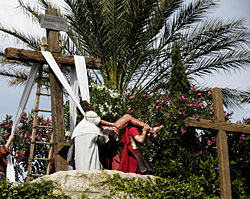Easter in the Holy Land
Every year, thousands of Christian pilgrims from around the world converge on the Old City of Jerusalem to celebrate the Holy Week of Easter at the biblical site of Jesus’ crucifixion and resurrection.
to celebrate the Holy Week of Easter at the biblical site of Jesus’ crucifixion and resurrection.
In addition to international visitors, Jerusalem also welcomes hundreds of Palestinian Christians from nearby Bethlehem, the site of Jesus’ birth. Their pilgrimage, however, is often determined by political rather than religious considerations. When tensions are running high, Israeli security forces must frequently restrict Palestinian visitor permits.
Holy Week festivities in Jerusalem begin on Palm Sunday, one week before Easter Sunday, with a pilgrim procession from the Mount of Olives to the Old City.
According to tradition, the Palm Sunday procession follows the same path that Jesus took on his triumphant return to Jerusalem. Two thousands years ago, Jesus rode on a donkey as followers laid palm branches along his path. Today, pilgrims march on foot, waving palm fronds and olive branches.
On Good Friday, pilgrims retrace Jesus’ procession toward his crucifixion along the cobble stoned Via Dolorosa. This reenacted march along the Stations of the Cross features many of Jerusalem’s most historic Christian sites.
During the Via Dolorosa procession, pilgrims can be seen carrying large wooden crosses – some 15 feet tall – and reciting prayers at each of the fourteen Stations of the Cross.
Their procession begins at the Sanctuary of the Flagellation, where Jesus was scourged and judged, and ends at the Church of Holy Sepulcher, where Jesus was stripped of his garments, nailed to the cross and died.
According to Roman Catholic and Orthodox traditions, Jesus was buried in the chamber of the sepulcher and later resurrected from there, making the Church of the Holy Sepulcher a focal point of the modern day pilgrimage. Protestant denominations believe Jesus was buried in the nearby Garden Tomb.
On Easter Sunday, pilgrims and local Christians celebrate together Jesus’ resurrection and his rebirth. Special masses, vigils and services are held throughout the Old City, including more than twenty separate masses conducted within 24 hours at the Church of the Holy Sepulcher. Christians in Bethlehem hold candlelight prayers at the Church of the Nativity.
During Easter week, Jerusalem’s Old City works hard to accommodate the six Christian sects who are represented in the Church of the Holy Sepulcher: Roman Catholic, Armenian Orthodox, Greek Orthodox, Egyptian Coptic, Ethiopian, and Syrian Orthodox.
The Eastern and Orthodox churches follow a different calendar than the Roman Catholic and Protestant churches, so their Easter is often as much as two weeks after the Gregorian calendar celebration.
This natural scheduling difference often helps reduce territorial tension in the Church of the Holy Sepulcher. The Church also gives each denomination its own space and separate schedules for permitted prayer times.
In 2007, however, the Christian calendars overlapped for the first time in four years, bringing all Christian pilgrims to the Holy City at the same time. Peace was maintained by tight scheduling of mass times and crowd control from Israeli police and local church leaders.



